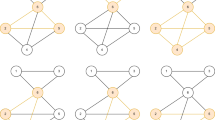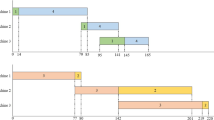Abstract
This paper presents a new clique partitioning (CP) model for the Group Technology (GT) problem. The new model, based on a novel 0/1 quadratic programming formulation, addresses multiple objectives in GT problems by drawing on production relationships to assign differing weights to machine/part pairs. The use of this model, which is readily solved by a basic tabu search heuristic, is illustrated by solving 36 standard test problems from the literature. The efficiency of our new CP model is further illustrated by solving three large scale problems whose linear programming relaxations are much too large to be solved by CPLEX. An analysis of the quality of the solutions produced along with comparisons made with other models and methods highlight both the attractiveness and robustness of the proposed method.
Similar content being viewed by others
References
Boctor F (1989) Alternative formulations of the machine-part cell formation problem., presented at Proc. 3rd ORSA/TIMS Conf. On Flexible Manufacturing Systems, Amsterdam
Boctor F (1991) A linear formulation of the machine-part cell formation problem. Int J Prod Res 29:343–356
Boe WJ, Cheng CH (1991) A close neighbor algorithm for designing cellular manufacturing systems. Int J Prod Res 29:2097–2116
Burbidge JL (1963) Production flow analysis. Prod Eng 42:742–752
Burbidge JL (1991) Production flow analysis for planning group technology. J Operat Manage, Special Issue Group Technol Cell Manuf 10:5–27
Cantamessa M, Turroni A (1997) A pragmatic approach to machine and part grouping in cellular manufacturing system design. Int J Prod Res 35(4):1031–1050
Chan HM, Milner DA (1982) Direct clustering algorithm for group formation in cellular manufacturing. J Manuf Syst 1:65–74
Chandrasekharan MP, Rajagopalan R (1986) MODROC: an extension of rank order clustering for group technology. Int J Prod Res 24:1221–1233
Chandrasekharan MP, Rajagopalan R (1987) ZODIAC—an algorithm for concurrent formation of part-families and machine-cells. Int J Prod Res 25:835–850
Chopra S, Rao MR (1993) The partition problem. Mathemat Progr 59:87–115
Chu CH (1995) Recent advances in math programming for cell formation. In: Kamrani AK, Parsaei HR, Liles DH (eds) Manufacturing research and technology, Vol 24. Elsevier Science Publishing, Amsterdam, pp 3–46
Glover F, Kochenberger GA, Alidaee B (1998) Adaptive memory tabu search for binary quadratic programs. Manage Sci 44:336
Grotschel M, Wakabayashi Y (1989) A cutting plane algorithm for a clustering problem. Mathemat Progr 45:59–96
Grotschel M, Wakabayashi Y (1990) Facets of the clique partitioning polytope. Mathemat Progr 47:367–387
Gunasingh K, Lashkari R (1990) Simultaneous Grouping of Parts and Machines in Cellular Manufacturing Systems—an Integer programming approach. Comput Indust Eng 20:111–117
Ham I, Hitomi K, Yoshida T (1985) Group technology: applications to production management. Kluwer publishing, Boston
Hansen PB (1979) Methods of nonlinear 0–1 programming. Ann Dis Math 5:53–70
Hansen PB, Jaumard B, Mathon V (1993) constrained nonlinear 0–1 programming. J Comput 5:97
Islamt KMS, Sarker BR (2000) A similarity coefficient measure and machine-parts grouping in cellular manufacturing systems. Int J Prod Res 38:699–720
Jaumard B, Labit P, Ribeiro C (1999) A Column Generation Approach to Cell Formation Problems in Cellular Manufacturing. In: 3rd International Industrial Engineering Conference. Montreal, Canada
Joglekar P, Chund Q, Tavana M (2001) Note on a comparative evaluation of nine well-know algorithm for solving the cell formation problem in group technology. J Appl Mathemat Decision Sci 5:253–267
Joines JA, Culbreth CT, King RE (1996) Manufacturing cell design: an integer programming model employing genetic algorithms. IIE Trans 28:69–85
Kattan I (1997) Design and scheduling of hybrid multi-cell flexible manufacturing systems. Int J Prod Res 35:1239–1257
King JR (1980a) Machine component group formation in group technology. Omega 8:193–199
King JR (1980b) Machine component grouping in production flow analysis: an approach using rank order clustering. Int J Prod Res 18:213–232
King JR, Nakornchal V (1982) Machine component group formation in group technology, review and extension. Int J Prod Res 20:117–133
Kochenberger G, Glover F, Alidaee B, Rego C (2004) A Unified Modeling and Solution Framework for Combinatorial Optimization Problems. Operat Res Spectrum 26:237–250
Kumar RK, Kusiak A, Vannelli A (1986) Grouping of parts and components in flexible manufacturing systems. Eur J Operat Res 24:387–397
Leskowski Z, Logan L, Vanelli A (1987) Group technology decision aids in an expert system for plaint layout, presented at Modern production management system: Proc IFIP TC 5/WG 5-7 Working Conf. On Advances in Production Management Systems, Amsterdam
Li M, Parkin R (1997) Group technology revisited: a simple and robust algorithm with enhanced capability. Int J Prod Res 35:1969–1992
Malakooti B, Yang Z (2002) Multiple criteria approach and generation of efficient alternatives for machine-part family formation in group technology. IIE Trans 34:837–846
Malakooti B, Zhou Y (1998) Approximating polynomial functions by feedforward artificial neural networks: capacity, analysis and design. Appl Mathemat Comput 90:27–52
Masnata A, Settineri L (1997) An application of fuzzy clustering to cellular manufacturing. Int J Prod Res 35:1077–1094
Mccormick WT, Schweitzer PJ, White TW (1972) Problem decomposition and data reorganization by a clustering technique. Operat Res 20:993–1009
Mehrotra A, Trick M (1998) Clique and clustering: a combinatorial approach. Operat Res Lett 22:1–12
Miltenburg J, Zhang W (1991) A comparative evaluation of nine well-known algorithms for solving the cell formation in group technology. J Operat Manage 10:44–72
Nair GJ, Narendran TT (1996) Grouping index: a new quantitative criterion for goodness of block-diagonal forms in group technology. Int J Prod Res 34:2767–2782
Oosten M, Rutten J, Spieksma F (2001) The Clique partitioning problem: facets and patching facets. Networks 38:209–226
Rajagopalan R, Batra JL (1975) Design of cellular production systems. Int J Prod Res 13:567–579
Rogers DF, Kulkarni SS (2005) Optimal bivariate clustering and a genetic algorithm with an application in cellular manufacturing. Eur J Operat Res 160:423–444
Seifoddini H (1988) Machine grouping—expert systems: Comparison between single linkage and average linkage clustering techniques in forming machine cells. Comput Indust Eng 15:210–216
Seifoddini H, Wolfc PM (1986) Application of the similarity coefficient method in group technology. IIE Trans 18:271–277
Shafer SM, Rogers DF (1993) Similarity and distance measures for cellular manufacturing: Part 1: a survey. Int J Prod Res 31:1133–1142
Sofianopoulou S (1997) Application of simulated annealing to a linear model forthe formulation of machine cells in group technology. Int J Prod Res 35:501–511
Sule D (1991) Machine capacity planning in group technology. Int J Prod Res 29:1902–1922
Vannelli A, Kumar KR (1986) A method for finding minimal bottleneck cells for grouping part-machine families. Int J Prod Res 24:387–400
Author information
Authors and Affiliations
Corresponding author
Appendix: Overview of tabu search method for CBQP
Appendix: Overview of tabu search method for CBQP
Our TS method for CBQP is centred around the use of strategic oscillation, which constitutes one of the primary strategies of tabu search. The variant of strategic oscillation we employ may be sketched in overview as follows.
The method alternates between constructive phases that progressively set variables to 1 (whose steps we call “add moves”) and destructive phases that progressively set variables to 0 (whose steps we call “drops moves”). To control the underlying search process, we use a memory structure that is updated at critical events, identified by conditions that generate a subclass of locally optimal solutions. Solutions corresponding to critical events are called critical solutions. For CBQP a critical event occurs during the solution process when exactly n variables are equal to 1.
A parameter span is used to indicate the amplitude of oscillation about a critical event. We begin with span equal to 1 and gradually increase it to some limiting value. For each value of span, a series of alternating constructive and destructive phases is executed before progressing to the next value. At the limiting point, span is gradually decreased, allowing again for a series of alternating constructive and destructive phases. When span reaches a value of 1, a complete span cycle has been completed and the next cycle is launched.
Information stored at critical events is used to influence the search process by penalizing potentially attractive add moves (during a constructive phase) and inducing drop moves (during a destructive phase) associated with assignments of values to variables in recent critical solutions. Cumulative critical event information is used to introduce a subtle long term bias into the search process by means of additional penalties and inducements similar to those discussed above.
Rights and permissions
About this article
Cite this article
Wang, H., Alidaee, B., Glover, F. et al. Solving group technology problems via clique partitioning. Int J Flex Manuf Syst 18, 77–97 (2006). https://doi.org/10.1007/s10696-006-9011-3
Published:
Issue Date:
DOI: https://doi.org/10.1007/s10696-006-9011-3




